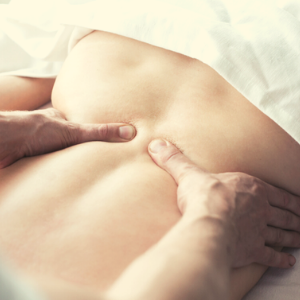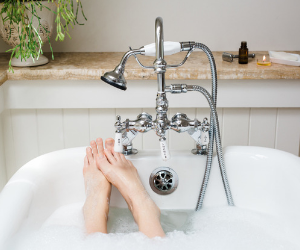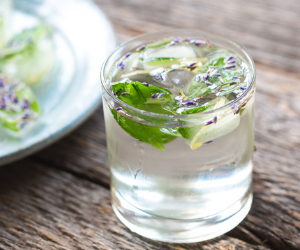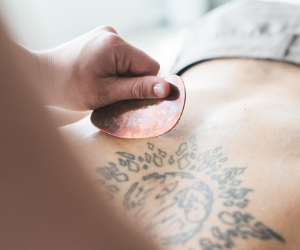|
If you’ve ever battled lower back pain, you know how nagging and exhausting it can be.
Pain medications can be dangerous to take for extended periods (and frequently only dull the pain, instead of dealing with it), relief found from injections is ineffective or short-lived, and some therapies can even make your lower back pain worse. Surely there’s something you can do to rid yourself of this pain. You’re not alone in this pain. In fact, at least 80% of adults will deal with lower back pain at some point in their life. So how can we work to free you of this pain if most of these treatments are ineffective? Good news: You don’t have to give in and deal with this pain. There are solutions out there. There must be something your doctor can prescribe that can cut through lower back pain, right? If this is so common, surely there is a solid, proven fix! Unfortunately, there is no one solution and it typically takes a combination of efforts and time to get through an episode of pain. Pain medications Pain killers and certain types of muscle relaxers can be helpful short-term to relieve debilitating pain and help you get a good night’s sleep when you’re hurting from an injury or ‘my back went out!’ incident. But long-term usage of prescription pain medications is not a great management option. And long-term use of over-the-counter medications like ibuprofen and acetaminophen can increase your risk of stomach, cardiac, and liver and kidney issues. Steroid injections Just like pain meds, injections can be helpful for short term, immediate treatment of pain or swelling. Multiple injections can cause tissue damage over time, so the use is limited. Chiropractic To treat low back pain, chiropractors use hands-on techniques to manipulate the spine and hips and often incorporate soft tissue work, stretching, heat or cold. Physical Therapy A great physical therapist can help to assess and treat low back pain. Once the pain decreases and your quality of life improves again, your physical therapist can help you create a preventive routine of exercise and stretching. Massage Therapy Obviously, we are fans of massage therapy! We’ve had great results treating low back pain in our practice. And there’s a growing body of research to support the use of massage therapy for low back pain! This study showed that both weekly whole body Swedish massages for relaxation and weekly massages focused on the lower back and hips were able to alleviate some of the pain - at least 2 to 4 points on the pain scale. This kind of improvement is actually a bit better than the relief found in over-the-counter meds like ibuprofen. The study also showed that these regular massage sessions can alleviate enough pain for many with chronic back pain to hit the gym for strengthening and aerobic exercise to help remove much of the pain completely. Our goal with your regular massage sessions is to locate the source of your pain and work to lessen it. We want to help to improve your physical function and get your life back on track. We know how much lower back pain can affect your life. From physical activity to time with family to simple activities like tying your shoes or pulling laundry out of the dryer, you feel lower back pain all the time. Let’s work together to get you on the path to freedom from lower back pain. You deserve a healthy lifestyle, free from pain. Ready to get started? Book your appointment here https://www.massagebook.com/biz/WillowBowMassageTherapy and let’s get started.
9 Comments
Stressors come in all kinds of forms: work and school pressures, relationships, health concerns, uncertainty about the future. Even changes that are generally positive can still be incredibly stressful, like gaining a family member or starting a new business. Left unchecked, stress can lead to a host of symptoms, including headaches, disrupted sleep, nausea, irritability, lack of focus, and poor impulse control. Tips for stress management are frequently repeated and generally well-known: Get some exercise! Talk with a friend! Breathe deeply! Get a massage![1]
But while most of us recognize at least a few of these symptoms from stressful periods in our own lives (and if you don’t, please teach the rest of us what your secret is!), stress isn’t exclusive to the adult world. Our children experience stress too. And while parents and children can often be high up on the list of one another’s stressors, we’re generally stuck with each other. So while it’s nice to talk about individual stress-busters, ways to help the whole family manage stress at once can be a lifesaver for parents and kids (and grandparents, stepparents, aunts and uncles, godparents, siblings, friends-who-function-as-family, and 32 flavors of cousins) to tackle their stress head-on. Create a traditionWhen you think of traditions, you might think of holiday foods, first day of school photos, or the neighborhood block party that’s happened every Labor Day for the last 40 years. But traditions are, essentially, some kind of activity that is regular and predictable. It’s a fancy way of saying “routine.” If you read before going to bed? That’s a tradition. If you always make a point of yelling angrily at the Mad River when you cross it? That’s a tradition. Traditions and routines matter because they help kids (and adults) feel like the future is a little bit more predictable. So if you’re staying with friends to stay safe during a natural disaster, at least there’s still reading before bed to count on. Every bit of stability helps. New traditions can mean formalizing something you do haphazardly anyway. If Wednesday means a trip to the library or the first day of school vacation involves eating pancakes in your pjs, that’s a tradition. Write ridiculous songs for birthdays. Start a game night. Invent a holiday. Just don’t let your traditions become a source of stress itself. If the regularity or specificity isn’t serving your family, let it go. Try something new instead. Find a shared hobbyGetting involved in a productive hobby is often touted as a great way to manage stress, but in families that are already over-scheduled, the idea of adding more to the plate can feel overwhelming. The solution is to find something that the entire family can enjoy together, which is still a challenge. If one of you likes to play Call of Duty and the other prefers reading regency romance novels, there’s a chance one of you will like the other … but it’s not altogether likely. Better is to find something that’s new to everyone. You’re into painting and they’re all about Minecraft? Consider designing and building a treehouse together. You’ve got three super active family members and one with a bad knee? Swimming could fit the bill. Some folks in the family are aspiring globetrotters while others hate to leave the house? Borrow some international cookbooks and explore the world from the comfort of your kitchen. (There is very little more soothing than kneading dough.) Get active togetherAh yes, the old “exercise” advice. Well, it’s here for a reason: physical activity really is good for stress management, so long as you’re doing it in a way that’s both physically and emotionally healthy. The same goes for kids of all ages, but to an even greater degree. So without creating stress about it, try to find ways to be active together. Some ideas include:
Keep in mind that some people thrive in a competitive environment, while others don’t. Think about that before jumping into any kind of formal sport. Schedule downtimeDoes that seem like a contradiction in terms? It’s really not. In today’s busy world, kids and adults have much of their lives planned down to the minute, and open-ended time is losing out. But downtime is critical for stress management, so the easiest solution is to formalize downtime by actually putting it on the schedule. Time for playing, reading, chilling, whatever. Children need downtime in order to deal with the stress of everyday life. Teens need downtime. You need downtime. So get that time on the calendar and plan for … absolutely nothing serious. Do whatever feels right at the time, even if that’s nothing at all. Need some help? Family therapy is awesome.If you feel like your family has been through some extra stressful stuff lately, or even if you just feel like you want to be doing a better job of handling stress as a family, seeing a therapist can be incredibly helpful. Family therapy isn’t exclusively for families that are dysfunctional. A professional can help provide guidance in a way that’s tailored to both the individuals in your family, and how you function as a unit. Stress is never going to go away completely. And that’s a good thing.Situations feel stressful because they’re challenging. And challenges can be incredibly helpful in getting us to grow. A tough school or work assignment can teach you new skills, while an argument with a loved one can help you look at your preconceptions from a different perspective. It’s when stress becomes toxic that it really starts to negatively impact our lives, physically as well as mentally and emotionally. The trick is to manage your stress before it gets to that point, both for you, and for your family. So breathe deeply. Go for a walk. Get that massage. Get your kid a massage. And remember that you’re all in this together. Even if that’s a little stressful sometimes. https://www.massagebook.com/biz/WillowBowMassageTherapy There are so many articles out there about “healthy aging”, but most of them are bizarrely vague. Like ads for menstrual products or incontinence, they seem to be convinced that we’d all run away screaming if they actually mentioned what aging is actually like, so we’re left with commercials of silver-haired couples taking romantic strolls on the beach, senior women lifting two-pound weights in yoga pants, and similarly-aged men mowing the lawn and looking purposefully at the horizon. It’s not that there’s anything wrong with beach dates or light workouts, but it doesn’t really address the issue of aging head-on. It’s like a dream of healthy seniorhood, as imagined by people who still don’t believe they’ll ever actually be old.
(Yes, I said old. It’s not a dirty word!) But even if it’s usually polished up beyond recognition, healthy aging is a major concern. Across the world, the percentage of the population over the age of sixty is increasing, and by 2050 this percentage is expected to surpass 30% in Canada and most of Europe. We aren’t, as the saying goes, getting any younger. So what does it mean to age well? And what do we need to do in order to get there? Defining healthy agingHealth is a broad term that means different things for different people. But in general, it’s looking at functional ability, regardless of the particular quirks that your own body or mind develops as you age. The World Health Organization defines functional ability in the following terms:
We’ll take a look at each of these in a little more detail. Meeting your needsOkay, that’s a HUGE category. It means healthy finances, a safe place to live, warm clothes, clean water, nutritious food. It means access to whatever medications or treatments (including massage) that keep you functioning. If you’re having problems with some aspect of meeting your basic, needs, it means you have supports in place to help with that, whether these are physical supports like a grab bar in the bathroom, mental supports like reminders to take care of important tasks, or social supports like a neighbor who checks in on you regularly. For those of us who are wondering how to age well, it means making plans for how these needs will be met in the future. Talking with your primary care physician, your financial planner, your family, and even your friends can help you build a solid plan for ensuring your needs continue to be met over the coming years. Learning, growing, and making decisionsLearning and growth are a huge part of a happy and healthy life. It can be comfortable to fall into routines, but that shouldn’t stop you from branching out as well. Reading a book, taking a dance class, or exploring a new museum or park are all simple examples. More challenging can be traveling, taking up an entirely new hobby, or learning another language. But the greatest fear that many people have about getting older isn’t about failing to learn new things. It’s not even developing poor health. It’s the potential for lost autonomy. The longer you’ve been empowered to make your own decisions, the more you cherish it. The idea of losing that is horrifying. This is especially true when we think about the two primary sets of people who might take on our decision-making power down the road: our own children, for whom we made decisions for years, and strangers. As we get older, most of us end up leaning more heavily on others than we would have wished. What’s the solution here? Making as many decisions as possible now. Again, this involves some (possibly uncomfortable) conversations, especially with family members who’d rather pretend aging simply doesn’t happen. An advance directive is also a key part of this process. Five Wishes is one of the easiest and most common versions of this form, and makes your choices known in five key areas:
Even if not choosing this particular template, developing an advance directive is a good practice for people of all ages to consider, if they want to preserve their decision-making powers in the event of a catastrophic illness or injury. Staying mobileMobility comes in two flavors. The first is the ability to get around by the power of your own body. The very best thing you can do to maintain your mobility is to use your mobility. That means taking advantage of opportunities to walk, exercise, and stretch. Strength training can help, as well as getting regular massage. (Hello!) For folks whose mobility is limited in one or more ways, this can require taking advantage of what your body can do, even while there are things it can’t. Maybe you take t’ai chi instead of Zumba fitness, or you walk laps in the pool instead of around the track. Your physician or physical therapist can help you figure out what maintaining your personal mobility looks like. The second form of mobility is about how you get around in the world. People in their 80s often give up driving for a number of reasons, most commonly due to vision problems. Having access to alternative sources of transportation can be huge in assuring quality of life as we age. Living within walking distance of important resources such as grocery stores, pharmacies, and social spaces can as well. Building and maintaining relationshipsSome people naturally seem to collect new friends wherever they go. The introverts among us struggle a little more. Either way, building and maintaining relationships with others is a key part of health at every stage of life. Volunteering is a fantastic way to get to know people in a structured environment. Groups based around walking, reading, gardening, games, or other hobbies are another great option. Whatever you choose, you’ll be spending time with people who enjoy and appreciate the same things you do. And what about family? If you’re lucky, they also fall into this category. If you’re not so lucky, these relationships can be fraught with challenges. It’s worth considering individual or family therapy if there are family relationship you’d like to strengthen. And if they’re not the sort of relationships that ought to be maintained, a good therapist can help you through that process as well. Contributing to societyKnow that you have something to offer the world. It doesn’t matter whether you’ve spent most of your life as a NASA scientist or a full-time parent, whether you were a pillar of the community or the town’s biggest screw-up. If you believe that the world could be better with a little help, you are never too old to offer it. Volunteer. Share your experiences. Model your values. Make the world more just, friendly, beautiful, or honest. A huge part of health is hope. So act on it, however you can. Aging isn’t always easy.It would be nice if our minds and bodies kept functioning as though we were perpetually 25, but that’s not the reality we live in. What is our reality is that we have choices available to us that can help us lead meaningful and fulfilling lives at every age, even as we face new challenges. So today? Think a little bit about the future. Plan to take that walk, call your sister, write that op-ed, or schedule that massage https://www.massagebook.com/biz/WillowBowMassageTherapy. Aging isn’t always easy, but it’s a privilege all the same. So here’s to making the most of the opportunity. Pain is one of those “you know it when you feel it” kind of sensations. But it’s also a strange phenomenon, when you think about it. A snowball is cold, and so it feels cold when you touch it. A block of concrete is rough, so it feels rough when you touch it. But a knife isn’t painful on its own. Neither is a pot of boiling water or the leg of a table. We handle these things safely all the time, and experience their mass and temperature and texture. But pain exists only in the body, and even more specifically (as people who’ve experienced anesthesia know firsthand) in our minds. But that doesn’t make it less real! So what exactly is happening when we feel pain, and how do we stop it from negatively impacting our lives?
How does pain work?There are three primary types of pain, and each of them works a slightly different way. Nociceptive pain (tissue pain).There are many different kinds of sense receptors in the body. Some are sensitive to heat or cold, some to touch or pressure. Others, called free nerve endings, aren’t specialized for any one type of stimulus. When a significant stimulus triggers these nerve endings, they send a message through the spinal cord and up to the brain indicating that something potentially dangerous has happened. The brain then decides (without consulting the part involved in conscious thought, alas) whether this is something to ignore or brush off or if it seems likely that damage has occurred. This then sends this message back down to the affected part of the body. If the message is “No biggie, ‘tis but a scratch,” then you’ll most likely shake yourself off and forget the incident even happened. If it’s “WHOA, THIS SEEMS LIKE A PROBLEM,” then you experience this as pain. This is useful! Just ask someone with CIPA, or congenital insensitivity to pain with anhidrosis, a disease that leaves people insensitive to pain. Imagine not noticing a bit of grit in your eye until it damages your cornea, developing stress fractures in your feet because nothing is telling you it’s time to sit down, or ending up with burns in your mouth and throat because you don’t realize your coffee is scalding hot. Pain stops us from trying to walk on a sprained ankle or go for a run when we have a fever. Tissue damage, high temperatures, low pH, and capsaicin (the active ingredient in hot peppers) are all common triggers for this process. But brains aren’t always correct when it comes to assessing danger. Lorimer Moseley gives a brilliant example of this in his TEDx talk. What’s the difference between the pain from a scratch on the leg and the pain from a nearly-fatal snake bite? Spoiler: it’s whatever your brain is expecting. That’s why you might feel little pain after a bicycle accident, but be in agony when getting the wound stitched up two hours later. Pain is weird. Neuropathic pain (nerve pain).This is pain that results from an issue with the nervous system itself, rather than surrounding tissues. If you’ve ever banged your funny bone, you know this feeling well. Common forms of neuropathic pain include:
Less common forms include phantom limb pain (pain that feels like it originates in an amputated limb) and postherpetic neuralgia, which occurs as a result of getting shingles. Neuropathic pain can be especially frustrating because the normal things we do to reduce pain are often useless when it comes to pain originating in the nervous system. Moving or not moving our muscles, applying heat or ice, these can have relatively little impact on nerve pain. What’s more, nerves don’t heal as well as things like muscles and skin do, which makes nerve pain more likely to become chronic pain. Other pain. (Yeah, that’s a terrible fake category name.)Pain is messy, and a lot of it doesn’t fall into either of the two categories above. Fibromyalgia is a great example of this. Is it pain resulting from tissue damage? Nope. What about nerve damage? Not as far as we can tell. It’s caused by the nervous system malfunctioning, sometimes in horrible ways, but that don’t result from actual nerve damage. Often a lot of it. And the world of medicine is still trying to figure out why. So how do we alleviate pain?There are several different options.
Feeling the hurt yourself? There’s a massage with your name on it. Book your next one today. https://www.massagebook.com/biz/WillowBowMassageTherapy We all know that stress in life is a guarantee. Stress is necessary for life and can be a positive motivator. However, when it starts to become too much for our bodies and minds to process, it can start to present in many ways that can be frustrating, overwhelming or downright alarming. Symptoms of too much stress can present itself mentally, physical and emotionally.
Some of the mental effects of too much stress can be subtle at first. Trouble learning new information is often associated with aging but can also be attributed to stress overload. Forgetfulness and difficulty making decisions are other ways that stress can affect your brain (ask any new mom!). Confusion and disorganization are two more signs that your stress levels are beyond a healthy level and that it is time to start seeking stress management solutions. Most people are more aware of the physical side effects of stress. Headaches, grinding teeth, muscle spasms, neck and back pain just to name a few. Some physical symptoms are less known such as light headedness, dry mouth, hives and tremors. Other physical ways stress can present are heartburn, stomach pain, nausea and difficulty breathing. After ruling out any medical conditions, stress management is critical for reacquiring quality of life. Emotional effects of stress are often the most disturbing for people. Just a few of the symptoms that people can experience are frequent crying, irritability, increased anger, depression, feeling overloaded and loneliness. How you will manage stress will be different than every other person, but I will share a few ideas with you to help you get started. Meditation is something you can do anywhere and there are lots of free resources to get you started. Exercise is a great way to release natural endorphins in the body and reduce stress, even something as simple as taking a walk can help. Regular massage therapy can be a way to reduce stress and alleviate the pain associated with it. Other ways to manage stress include yoga, listening to music, reducing your workload, spending time in nature and visiting friends. If you are ever overwhelmed, reach out to your doctor for evaluation or resources. https://www.stress.org/stress-effects Keeping hydrated is an important part of staying healthy. Water promotes cardiovascular health, keeps your body cool, helps muscles and joints work better and keeps skin supple. Here is this week’s hydration recipe:
Cantaloupe, Honey, and Mint Water Ingredients: ½ c water ½ c honey 4 c (about 2 lbs) cantaloupe cut into 1 inch pieces ¼ c fresh lime juice (about 2 limes) 2 Tbsp fresh mint leaves ¼ tsp salt sparkling water or club soda mint sprigs for garnish Instructions:
Whether it’s responsibilities for work, home, or the community, life has a way of getting incredibly busy. And it’s easy to let our everyday physical and mental health slip during such times. So how do you juggle all of your life commitments and still have time for your own needs? Here are some tips for staying all-around healthy—no matter how busy you are.
Keep an Eye on Portions One thing that helps you maintain your health is to pay attention to the portions you eat. Yes, what you eat matters, but so does how much you eat. Americans are eating more now than ever before, and the results are easily seen when you look at the obesity rates. A lot of it has to do with the consumer market, such as the servings at restaurants and packaged food from the grocery store. To help manage your portions, consider purchasing a quality digital food scale. These scales eliminate the guesswork by weighing ingredients and dishes. Measuring cups are another great option for keeping track of serving sizes. Once you have your digital scale and measuring cups, try meal prepping. Pick an evening each week to plan your meals, make a grocery list, and go shopping. Once you do it a few times, you’ll realize it really doesn’t take up a lot of your time, and it’s worth the time it does take because it gives you complete control of how much you and your family eat. Make Time for the Basics It is essential to leave room in your day for personal hygiene. It may sound funny, but many people overlook this step when life gets chaotic. Wake up early enough to give yourself ample time to shower, brush your teeth, fix your hair, sit down and have a healthy breakfast and coffee, and anything else you need to do to prepare for your day. It’s not a pleasant feeling to be in the middle of your 10 AM meeting and realize you didn’t brush your teeth. Make (and Keep) Appointments How many appointments have you forgotten about or canceled in the past two years? When life gets overwhelming, it’s easy to neglect important checkups and doctor appointments. But these appointments are how we gauge our current overall health, know what changes to make, and stay out in front of critical diagnoses. For example, make a point to maintain your regular checkups with your primary care physician once a year, and visit the dentist twice a year. Get a full-body screen at the dermatologist, see your OB-GYN, and get your eyes examined each year. And if you are a woman in your 40s or older, make sure to get a mammogram once a year. Prioritize Relaxation Making time for relaxation is essential for our mental health. This is when you wind down from your busy life and allow yourself to do something enjoyable (unrelated to work). Maybe this means saying no to working overtime so you can go on a family camping trip. Maybe it means getting a babysitter so you and your partner can go out for a night on the town. Or perhaps you just need to soak in a hot epsom salt bath and listen to soothing music. Whatever it is, you will only make relaxation happen if you prioritize it. Life gets crazy, but you can still maintain your health. Remember not to neglect basic personal hygiene. Try a digital food scale, measuring cups, and meal prepping to manage your portions. Don’t forget about or cancel important medical checkups and appointments. And make sure to carve out time in your schedule for relaxing. Taking steps such as these will help you stay healthy and bring consistency to your busy life. Guest Post by Jennifer McGregor @ publichealthlibrary.org This technique is an updated version of Gua Sha- a traditional Chinese medicine method of releasing pain (gua= scrape, sha= sand). Weighted, beveled steel tools are used to produce light petechiae (redness caused by capillary hemorrhage) in order to release fascia, restore movement, improve circulation and decrease pain. It is also known as the Graston Technique (named after David Graston who started the IASTM movement).
Benefits of this technique are: *to deliberately create micro-trauma and slight inflammation (petechiae)----eccentric exercises do the same thing, creating micro-tears in the muscle *to facilitate connective tissue healing *to release soft tissue hypertonicity, adhesions, and fascial restrictions *to modulate pain and tone by stimulating the parasympathetic nervous system to signal the brain to relax the area of tension or restriction Who can benefit? *Elite athletes *Weekend Warriors *Sports participants with overuse injuries (including children) *Migraine sufferers *Desk job employees *Anyone with old injuries who have scar tissue *Anyone with new injuries that need to prevent scar tissue abnormalities *Anyone with persistent trigger points (knots) that won't go away. Ever wonder why hot stones would be beneficial in a massage session? In addition to feeling amazing, there are a few other great benefits to adding in this little luxury.
Need deep work to get rid of trigger points (knots), or to lengthen some shortened muscles (this can happen when you assume one position for extended periods of time such as sitting at a desk all day)? Hot stones help to heat the muscle tissue allowing for deeper work, faster. This can allow your therapist to get to the deeper work quicker and spend more time on the type of work you really need. Do you have cold hands and feet? Hot stones are great at increasing circulation in the body. The heat quickly brings the blood flow to the surface and is a real treat when you have an area of the body that is chronically cold. This is also great for an older injury because bringing circulation to an area also brings nutrients your body uses to heal the tissue. Dealing with a lot of stress and need to just tune out? The heat from the stones has a very relaxing, almost sedative effect. Ask for a hot pack for your feet when you come in and get a double hit of heat. There is nothing quite like having toasty warm feet to increase your speed of relaxation. So, the next time you visit us for a massage, be sure to ask for hot stones. We will include them free in any massage. See you soon! Jessica Rodda Willow Bow Massage Therapy www.willowbowmassage.com You have tried for months (or years!) to get to this point. You are finally pregnant and are looking forward to the arrival of your new little one. Pregnancy is an exciting time for many. We plan and arrange and get ready in any way we can for this amazing little bundle. Often the process can be stressful, or uncomfortable, or down right painful! Prenatal massage is a great way to help the process go just a little smoother for mom (and baby!).
Your body is changing at a rapid pace as you grow a whole new person. Your blood supply increases drastically and can lead to swelling, nose bleeds, and headaches. Your ligaments loosen contributing to hip, ankle, knee, and even pelvic pain. Your center of gravity changes contributing to back and hip pain. And let’s not even go there with the weight gain! Yikes! If you are like me, you are looking for alternatives to medication when dealing with all the fun side effects of being pregnant. Massage can be a great option during pregnancy and has so many benefits. During our prenatal massages, once you are uncomfortable lying on your stomach or back (typically between 12-20 weeks), we will have you laying on your side throughout the massage. We use pillows, lots and lots of pillows to make sure you are comfortable and safe throughout your session. In this position, we have great access to your back, hips, and feet (all common problem areas when you are pregnant). We can still reach all areas of your body that you may want worked on, and will typically work the full body in an hour unless you have special requests otherwise. Pregnancy can be a stressful time, but is also so amazing and full of joy and excitement. Take a few minutes for yourself and schedule a massage. The baby also gets the stress reducing benefits of the massage, and who doesn’t want a calmer, more peaceful infant! Jessica Rodda Willow Bow Massage Therapy www.willowbowmassage.com |
AuthorMy name is Jessica Rodda and I have been a massage therapist for over 12 years. I love what I do and appreciate being able to follow my passion! Archives
January 2020
Categories |











 RSS Feed
RSS Feed